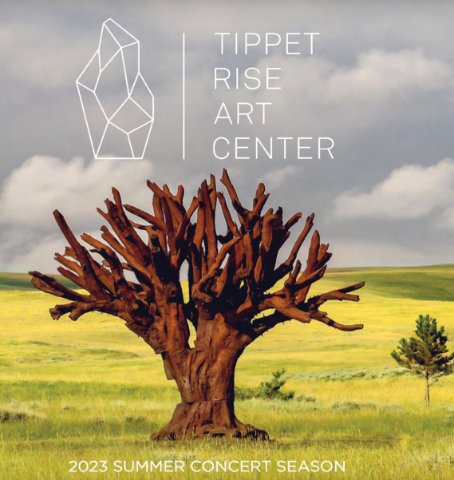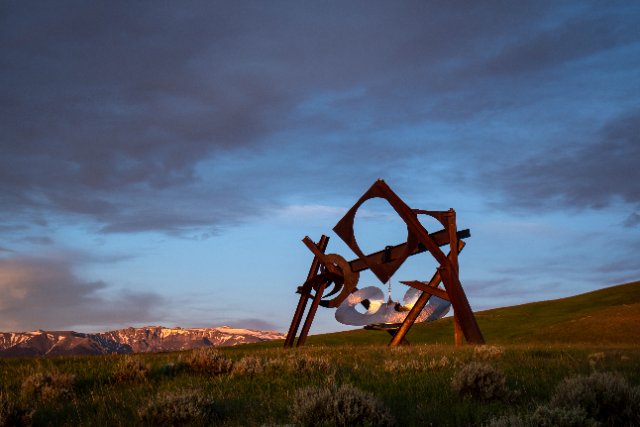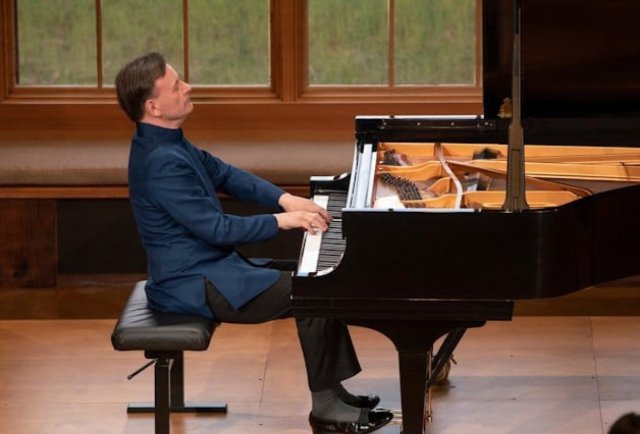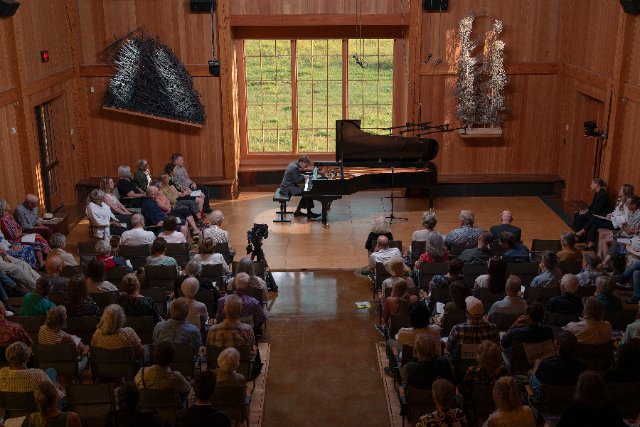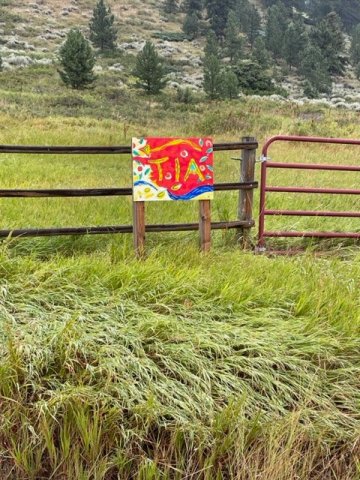A Visit to Tippet Rise, Part I
Local is the Future of Music and Art
By: Susan Hall - Aug 22, 2023
Tippet Rise is the passionate expression of Cathy Halstead, a painter, and Peter Halstead, a polymath (poet, pianist, photographer, and novelist) who met when they were very young and have lived like two peas in a pod ever since. Having assembled about 12,500 acres in southern Montana not far from Yellowstone National Park, they have taken cues from the natural surroundings to build concert halls, place site-specific architecture and sculptures and produce an annual summer music festival which is a model for the future.
Religious beliefs and rituals grew up because nature was terrifying. Now our spiritual attention is drawn to the havoc humans have wrecked on the natural world. At Tippet Rise, we feel at once quiet and also roused to protect what are in fact our origins.
The Halsteads hope “to make Tippet Rise a place where people feel the profound connection between their own inner nature and the natural world around them, a place where great music collaborates with the big sky and art is rooted deeply in the land.”
Big concert halls don’t work any more. Local productions attract a home-grown audience. In Fishtail, Montana, many audience members come from nearby Billings. They hunger for first-class world talent and also for a peek at future stars. Tickets are delegated by lottery in the spring. Every concert is sold out.
The first weekend of the 2023 Music Festival started with a performance by Sir Stephen Hough. When he was recently knighted by King Charles, the King whispered that he was grateful for the joy Sir Stephen brings to eager ears. And joy he certainly delivered in a concert that ranged from Frederic Mompou, a composer who Hough has brought to the music world’s attention, to Debussy’s Estampes, which sank us into the multi-paneled mountain landscape on display in windows behind the performer.
Mike Toia cares for the fifteen Steinway B pianos on-site at Tippet. Sir Stephen has selected a 1941 piano which Vladimir Horowitz used to perform concertos and also to record. Eugene Istomin toured small towns in the United States for seventeen years with this CD-18. It is bigger and brighter than the 1897 piano which will be the anchor of Sunday afternoon’s performance and glistened in Hough’s hands.
Hough's own composition Partita, a suite of delightful dances, filled the beautiful Olivier Music Barn concert room modeled on Haydn’s Esterházy Palace performing space. The concert hall is designed with an eye to Benjamin Britten's Snape Maltings roof, the shoebox surround-sound of Wigmore Hall, and the intimate acoustics of the Glyndebourne Opers House, which is surrounded by sheep-filled meadows. The Olivier Music Barn is one of the great performance spaces in America.
Sir Stephen followed his own work with Three Petrarch Sonnets of Liszt, which seem to be the prompt (or cannon shot) for Partita. Liszt is dashing and dazzling, but Hough adds the drama and the deep darkness which Peter Halstead likes so much. The audience was riveted.
While the audience was well-behaved in classical terms (and did not applaud between movements), Hough says that he doesn't mind applause anywhere in his program. It means the audience is listening. It means the audience appreciates magical moments.
Hough is a superb writer. What is the relationship between words and music? (Peter Halstead grapples with their links too.) In Hough’s most recent book Enough, he tells about about sudden rushes his fingers take when he gets too close to exposing parts of himself he would prefer to keep quiet. Hough has a tender sense of both offering himself up and protecting himself.
A brunch concert on Saturday honored a Ukrainian composer Valentyn Silvestrov. The first piece violinist Gidon Kremer performed with pianist Yulianna Avdeeva was an homage to Bach, in which the piano echoed the violin.
This was followed by Chaconne for Solo Piano by the Soviet composer Sofia Gubaidulina. Gubaidulina, like Hough, is a person of committed faith. Neither composer finds God tame. She is more like the fierce and beautiful nature with which we are surrounded at Tippet Rise. Her music says "God is angry" and is not for the faint of heart. Yet the chaconne performed by Yulianna Avdeeva was filled with a luminous delicacy.
Gidon and Madara Petersone played a charming two-violin duet by Alfred Schnitttke: Moz-art a la Haydn, where Papa Haydn is not dead and gone, but lingers on in Mozart. Five Bagatelles, composed by Silvestrov on a commission from Tippet Rise, were exquisitely performed by Avdeeva. The program concluded with Brahms, who sounded tame by comparison.
Concerts, if we continue to call them that, will in the future be in formats closer to Tippet Rise’s. Concert halls designed to bring an audience up close and personal move the listener's gut and heart.
In addition to the Olivier Music Barn, architecture and sculptural sites abound in the rolling hills and valleys of the ranch. A new structure, The Geode, by Arup was completed this year. It is designed both to protect an audience from the elements and enable enjoyment. Acoustics will offer ‘inside’ quality in this natural setting.
Over and over again as you tread on Tippet Rise trails, you feel the presence of nature and a spiritual aura from which the sculpture and the music arise, mixing and matching in unique and ineffable ways. Both Halsteads have great taste. It shows up in musical programming, sculpture selection, the choice of the ranch itself, where Montana’s most important artist Isabelle Johnson lived and worked. This is a working ranch. 10,000 cows graze. The sheep are not quite as brave as Ireland’s (who traipse across your path without blinking an eye), but you see them. Isabelle Johnson did paintings that depicted sheep's sheering in brush strokes at first literal and then abstract.
The Halsteads present artists from the world over along with local stars.Wendy Red Star’s thumbprint sculpture, now on display on the National Mall between Lincoln and Washington, will move to Tippet Rise. The Crows lived on the land, and the sculpture contains the names of Crow chiefs who signed treaties with the US government from 1825 on. Nearby is a Memorial to the 56 signers of the Declaration of Independence.
During my conversations with staff and artists a Tippet Rise, I kept pressing the accessibility issue. Tippet Rise is hard to get to. So is Tanglewood for that matter. Yet, instead of looking to build audience, the Halsteads offer a place for retreat. You can be alone. Yet I never felt lonely, hugged by the Beartooth Mountains, sculptures and sculpted buildings filling the eye and soul. Wonderful music is available live and also always streaming at the highest level of audio and visual transmission.
Music may also find its path to survival locally. Matthias Pintscher, a radical European conductor, is taking over the Kansas City Orchestra. Helzberg Hall will never be the same. Changes like this, and those at Tippet Rise, may pave the way to the future of performance and art. The Halsteads are leading the charge.
During off-season, children from local schools visit and learn. The neighborhood is swept up in the place. A sign made by school children lights up a fence. The wonderful paintings by Cathy Halstead are often filled with the geometric figures of nature and colored brightly in a palette of reds and yellows. I’d bet that the school children were given ‘Cathy colors’ to make the bright sign. It is a perfect welcome to Tippet Rise.

